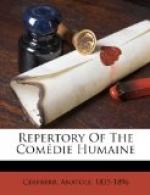ANTONIA—see Chocardelle, Mlle.
AQUILINA, a Parisian courtesan of the time of the Restoration and Louis Philippe. She claimed to be a Piedmontese. Of her true name she was ignorant. She had appropriated this nom de guerre from a character in the well-known tragedy by Otway, “Venice Preserved,” that she had chanced to read. At sixteen, pure and beautiful, at the time of her downfall, she had met Castanier, Nucingen’s cashier, who resolved to save her from evil for his own gain, and live maritally with her in the rue Richter. Aquilina then took the name of Madame de la Garde. At the same time of her relations with Castanier, she had for a lover a certain Leon, a petty officer in a regiment of infantry, and none other than one of the sergeants of Rochelle to be executed on the Place de Greve in 1822. Before this execution, in the reign of Louis XVIII., she attended a performance of “Le Comedien d’Etampes,” one evening at the Gymnase, when she laughed immoderately at the comical part played by Perlet. At the same time, Castanier, also present at this mirthful scene, but harassed by Melmoth, was experiencing the insufferable doom of a cruel hidden drama. [Melmoth Reconciled.] Her next appearance is at a famous orgy at the home of Frederic Taillefer, rue Joubert, in company with Emile Blondet, Rastignac, Bixiou and Raphael de Valentin. She was a magnificent girl of good figure, superb carriage, and striking though irregular features. Her glance and smile startled one. She always included some red trinket in her attire, in memory of her executed lover. [The Magic Skin.]
ARCOS (Comte d’), a Spanish grandee living in the Peninsula at the time of the expedition of Napoleon I. He would probably have married Maria-Pepita-Juana Marana de Mancini, had it not been for the peculiar incidents which brought about her marriage with the French officer, Francois Diard. [The Maranas.]
ARGAIOLO (Duc d’), a very rich and well-born Italian, the respected though aged husband of her who later became the Duchesse de Rhetore, to the perpetual grief of Albert Savarus. Argaiolo died, almost an octogenarian, in 1835. [Albert Savarus.]
ARGAIOLO (Duchesse d’), nee Soderini, wife of the Duc d’Argaiolo. She became a widow in 1835, and took as her second husband the Duc de Rhetore. (See Duchesse de Rhetore.) [Albert Savarus.]
ARRACHELAINE, surname of the rogue, Ruffard. (See that name.) [Scenes from a Courtesan’s Life.]
ARTHEZ (Daniel d’), one of the most illustrious authors of the nineteenth century, and one of those rare men who display “the unity of excellent talent and excellent character.” Born about 1794 or 1796. A Picard gentleman. In 1821, when about twenty-five, he was poverty-stricken and dwelt on the fifth floor of a dismal house in the rue des Quatre-Vents, Paris, where had also resided the illustrious surgeon Desplein, in his youth. There he fraternized with: Horace Bianchon, then




